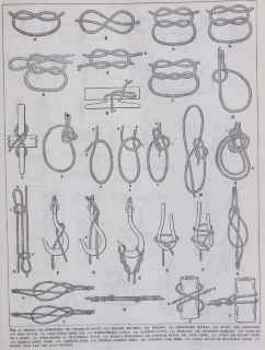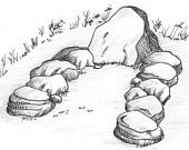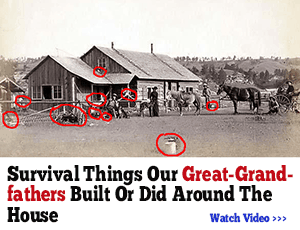The Best Strategies To Thrive When Modern Conveniences
Aren’t An Option
If you are thinking about participating in a peaceful protest demonstration, take some precautions because anytime you can get into a difficult situation.
‘The “Good Old Days” were those of just recent decades past. In the 1800s and centuries previous the pioneer folk had it unimaginably difficult. People grew soft – and had no idea. City folk could not even begin to do the work of the real farmers who still ran small farms.
An US candidate for president once promised 40 acres and a mule. I always said that the only way I would have possibly made it through the first winter was to eat the mule. The pioneers were survivalists and had survival skills beyond any that we can imagine.
In addition to not having the “toughness”, work habits and skills of the early pioneers – we do not have their resources. There are no buffalo herds and there is nowhere near that the deer and antelope play in sufficient number to support most survivors. Those who have taken survival courses that have taught them to go out into the woods and survive will be sorely disappointed. Such animals that have survived the radiation will be in very short supply relative to the survivors that would be in competition for them.
One will not have the horses, wagons or other implements that were necessary to pioneer survival. There will be a far larger population survive than there were pioneers a few centuries ago and there will be far fewer resources of the kind that sustained them. The early settlers of our village were confidant in their ability to find in a few minutes enough fish in the stream to make supper. Even in my early days in the village a person could promise the night before that they would go out on the bridge out our back door and get fresh fish for breakfast – and make good their promise. But those days are gone. Fished out and poisoned out by salt on the roads and pesticide run-off from the farmer’s fields. At this writing fish no longer come safe even from the farmer’s markets without warnings that they are hazardous to expectant mothers.
No, we can’t return to the old days – even if we want to. But fortunately we have many, many other advantages. We don’t have to cut the forests to gain agricultural ground. We know many things the pioneers did not. Childbirth was a great hazard to pioneer women – simply because people did not know to wash their hands. We have a great advantage in modern knowledege – but we may well need to supplement that, at least for a while, with some of the pioneer knowledge and skills that we have forgotten about. That is the purpose of this page.
This page does not stand by itself, anymore than do any of the others. There may be some items just as important to the subject that will be found in the pages on small farming but all that information will probably be just as important to know .'(source)
Pioneer Methods :
Learn how to grow food :
1# This is Incredible! The Self Watering Grow Bag Grow System! You got to see this!
5# Dutch Bucket Hydroponics – How It Works & How to Make Your Own Buckets
Harvesting seeds :
Saving tomato seeds is easy. Allow fruits to ripen fully and scoop out the seeds, along with the gel surrounding them, before you eat or cook the tomatoes. Put the seeds and gel in a glass jar with some water. Stir or swirl the mixture twice a day. The mixture will ferment and the seeds should sink to the bottom within five days. Pour off the liquid, rinse the seeds and spread them out to dry on paper towels.
Saving pepper seeds is even easier. Allow some fruits to stay on the plants until they become fully ripe and start to wrinkle. Remove the seeds from the peppers and spread them out to dry.
Save pea and bean seeds by allowing the pods to ripen on the plants until they’re dry and starting to turn brown, with the seeds rattling inside. This may be as long as a month after you would normally harvest the peas or beans to eat. Strip the pods from the plants and spread them out to dry indoors. They should dry at least two weeks before shelling, or you can leave the seeds in the pods until planting time.
Seeds Storage :
Store seeds in tightly-sealed glass containers. You can store different kinds of seeds, each in individual paper packets, together in a large container. Keep seeds dry and cool. A temperature between 32° and 41°F is ideal, so your refrigerator can be a good place to store seeds.
A small amount of silica-gel desiccant added to each container will absorb moisture from the air and help keep the seeds dry. Silica gel is sold in bulk for drying flowers at craft supply stores. Powdered milk can also be used as a desiccant. Use one to two tablespoons of milk powder from a freshly opened package. Wrap the powder in a piece of cheesecloth or a facial tissue and place it in the container with the seeds. Powdered milk will absorb excess moisture from the air for about six months.
Be sure to label your saved seeds with their name, variety, and the date you collected them. It’s too easy to forget the details by the following spring.
Don’t wait until food becomes scarce; start preparing for the future now by becoming as self-reliant as possible. Your long-term chances of survival could very well depend on your ability to feed yourself and your family without relying on someone else.
Six-months food storage :
– 200 lbs. flour
-half a bushel of corn meal
-half a bushel of corn, parched and ground(about 14 pounds)
-75 lbs. bacon(the pioneers called it “sowbelly”)
-30 lbs. hard tack (hard bread, today’s equivalent is pilot bread)
-25 lbs. sugar
-10 lbs. rice
-2 lbs.saleratus
-10 lbs. salt
-Keg vinegar(pioneers drank vinegar in a mixture of water, honey or
molasses and ginger)
-Brandy, rum and whiskey
-Sugar. Stock sugar in food grade bucket.
-Salt.( for preserving)
Coffee. The pioneers who drank coffee were the ones to survive the 2000-
mile journey!Contaminated water brought water-borne disease of cholera
with symptoms of high fever, vomiting and diarrhea. Pioneers prevented
sickness by drinking coffee. It was the process of boiling water that helped
purify the water. Coffee was important to many. If no coffee was available,
pioneers made a coffee-like substance from acorns, dandelion roots or
chicory. During the civil war the soldiers made substitutions with cotton seed
or peanuts.
A Self Sustaining Source Of Fresh Meat,Vegetables And Clean Drinking Water
Learn how to distill and purify water:
Water is the most important lesson of any survival skill overview. Often pioneers had no choice but to drink water made by human and animal waste. Coffee made it taste better. They could either drink foul water or die of dehydration, which wasn’t much of a choice. They “cured” sickness and disease with peppermint, whisky and rum. Vinegar was also a medicinal tonic to help ease their health woes. What a life!
One in ten travelers died the journey. Clean water was hard to find and the pioneers often died of dehydration or the perils of bitter alkaline water (too high ph), parasites in water and disease borne mosquitoes.
Discover The Amazing Device That Turns Air Into Water
How to make homemade laundry detergent :
- Grate the soap using a hand grater or food processor. Grate into fine particles so it dissolves easily.
- Carefully mix with the washing soda and borax (use gloves or a spoon as these can by drying if used directly on skin)
- Add essential oils and stir.
- Store in an air-tight glass jar.
- Use 1-2 tablespoons per load. Add 1 tablespoon of Oxygen booster if needed… I use this on white loads.
Laundry Detergent Ingredients :
- 1 bar of grated bar soap
- 1 cup of washing soda
- 1 cup ofborax (or additional washing soda)
- 20 drops of lavanda or LimeEssential Oils
- Optional: 1 cup of Oxygen Booster
Herbal Remedies :
An herb is a plant or plant part used for its scent, flavor, or therapeutic properties. Herbal medicines are one type of dietary supplement. People use herbal medicines to try to maintain or improve their health.
Many people believe that products labeled “natural” are always safe and good for them. This is not necessarily true. Herbal medicines do not have to go through the testing that drugs do. Some herbs, such as comfrey and ephedra, can cause serious harm. If you are thinking about using an herbal medicine, first get information on it from reliable sources. Make sure to tell your health care provider about any herbal medicines you are taking.
| Ailment
|
Herb
|
| Acne | Calendula, aloe, tea tree |
| Alcoholism | Evening primrose, kudzu |
| Allergy | Chamomile |
| Alzheimer’s disease | Ginkgo, rosemary |
| Angina | Hawthorn, garlic, willow, green tea |
| Anxiety and stress | Hops, kava, passionflower, valerian, chamomile, lavender |
| Arteriosclerosis | Garlic |
| Arthritis | Capsicum, ginger, turmeric, willow, cat’s claw, devil’s claw |
| Asthma | Coffee, ephedra, tea |
| Athlete’s foot | Topical tea tree oil |
| Attention-deficit disorder | Evening primrose oil |
| Bad breath | Parsley |
| Boils | Tea tree oil, topical garlic, echinacea, eleutherococcus, ginseng, rhodiola |
| Bronchitis | Echinacea, pelargonium |
| Burns | Aloe |
| Cancer | Bilberry, blackberry, cocoa (dark chocolate), green tea, garlic, ginseng, maitake mushroom, pomegranate, raspberry, reishi mushroom |
| Cankers | Goldenseal |
| Colds | Echinacea, andrographis, ginseng, coffee, licorice root (sore throat), tea (nasal and chest congestion) |
| Congestive heart failure | Hawthorn |
| Constipation | Apple, psyllium seed, senna |
| Cough | Eucalyptus |
| Depression | St. John’s wort |
| Diabetes, Type 2 | Garlic, beans (navy, pinto, black, etc.), cinnamon, eleutherococcus, flaxseed, green tea |
| Diabetic ulcers | Comfrey |
| Diarrhea | Bilberry, raspberry |
| Diverticulitis | Peppermint |
| Dizziness | Ginger, ginkgo |
| Earache | Echinacea |
| Eczema | Chamomile, topical borage seed oil, evening primrose oil |
| Fatigue | Cocoa (dark chocolate), coffee, eleutheroccocus, ginseng, rhodiola, tea |
| Flu | Echinacea, elderberry syrup (also see “Colds”) |
| Gas | Fennel, dill |
| Giardia | Goldenseal |
| Gingivitis | Goldenseal, green tea |
| Hay fever | Stinging nettle, butterbur |
| Herpes | Topical lemon balm, topical comfrey, echinacea, garlic, ginseng |
| High blood pressure | Garlic, beans, cocoa (dark chocolate), hawthorn |
| High blood sugar | Fenugreek |
| High cholesterol | Apple, cinnamon, cocoa (dark chocolate), evening primrose oil, flaxseed, soy foods, green tea |
| Hot flashes | Red clover, soy, black cohosh |
| Impotence | Yohimbe |
| Indigestion | Chamomile, ginger, peppermint |
| Infection | Topical tea tree oil, astragalus, echinacea, eleutherococcus, garlic, ginseng, rhodiola |
| Insomnia | Kava, evening primrose, hops, lemon balm, valerian |
| Irregular heartbeat | Hawthorn |
| Irregularity | Senna, psyllium seed |
| Irritable bowel syndrome | Chamomile, peppermint |
| Lower back pain | Thymol, carvacrol, white willow bark |
| Menstrual cramps | Kava, raspberry, chasteberry |
| Migraine | Feverfew, butterbur |
| Morning sickness | Ginger |
| Muscle pain | Capsicum, wintergreen |
| Nausea | Ginger |
| Premenstrual syndrome | Chasteberry, evening primrose |
| Ringing in the ears | Ginkgo |
| Seasonal affective disorder | St. John’s wort |
| Shingles | Capsicum |
| Sore throat | Licorice, marshmallow, mullein |
| Stuffy nose | Echinacea |
| Tonsillitis | Goldenseal, astragalus, echinacea |
| Toothache | Willow, clove oil |
| Ulcers | Aloe, licorice |
| Varicosities | Bilberry, horse chestnut |
| Yeast infection | Garlic, goldenseal, Pau D’arco |
Best Post Collapse First Aid Survival Guide Ever
Hunting deer is almost always a unique experience, whether or not you bag a big one. Of course, your goal should always be to an on target, quick and humane kill, but sometimes just communing with nature in the vast outdoors is all it takes to boost your spirits. If you want to increase your chances of success, and have fun doing it, here are some essential pointers for your deer hunting excursion.
It’s very important to stay as quiet as possible immediately before shooting, otherwise you risk spooking the deer. This will often depend on what kind of weapon you’re using to hunt.
If using a gun or crossbow, have your weapon fully loaded with the safety on. Then, all you need to do when you’re ready to shoot is flip the safety off and pull the trigger. Don’t be caught with your proverbial pants down and forget to load your weapon.
If the deer is still walking and won’t stop for you to get a good shot, make a short bleat sound. This will catch the deer’s attention, giving you time to shoot. You must be quick though because if you take a long time to shoot after bleating the deer will spook and run away.
If using a bow and arrow, be very methodical when you load your arrow in the draw. Try to stand up when bow hunting. It’ll improve your form and won’t limit the type of shots you can take.
Learn how to tie various knots :
Wood fired iron cook stoves:
The wealthiest few brought cast iron cook stoves; however, this proved too heavy for oxen to carry for the entire 2000-mile journey, so often families had to depart leaving their cook stove at the campsite.
‘How to Build a Campfire for Cooking :
The object is to have all the wood turn into coals at the same time. This gives an even fire with no flames reaching up to burn your food or blacken your cookware. It also yields the longest cooking time from the coals.
– Select a fire site at least 8′ from bushes or any combustibles. Be sure no tree branches overhang the site.
– Make a U-shaped perimeter using large rocks or green logs. If using logs, they’ll need to be wet down from time to time. If breezy, have back of firepit face the wind.
– Put a large flat rock at the rear of the firepit to act as a chimney. The “chimney rock” will help direct the smoke up and away.
Lay the kindling 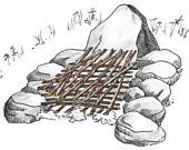
– Fill the fire area with crumpled paper or tinder.
– Lay kindling over paper in layers, alternating direction with each layer. Use thin splits of wood or small dead branches. Do not put kindling down “teepee style”. The whole fire area should be covered with the kindling stack.
– Set a bucket of water near the fire area. Light the paper to start your fire.
Build the fire, grade the coals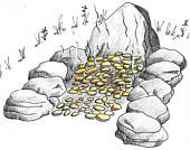
– When kindling is ablaze, add firewood. The wood should be all the same size, as much as possible. Use hardwood or hardwood branches if available. Distribute wood evenly over fire bed.
– As soon as the last flames die down leaving mostly white coals, use a stick to push the coals into a higher level at the back end and lower level at the front. This will give you the equivalent of ‘Hi’, ‘Med’ and ‘Lo’ cook settings. Or, level the coals to your preference.
To cook, set the grill on rocks or wetted green logs.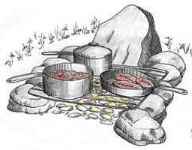
Put food directly on grill or in cookware and prepare your meal. If cooking directly on the grill, a small spray bottle or squirt gun is handy for shooting down any rogue flames, usually caused by food drippings.
As the fire diminishes, bank the coals to get the most heat from them.After cooking, add wood for your evening campfire. Before retiring, extinguish thoroughly and soak with water. Turn rocks in on fire bed. It will be easy to reassemble the next day if required.'(source)
Word of the day: Prepare! And do it the old fashion way, like our fore-fathers did it and succeed long before us, because what lies ahead of us will require all the help we can get. Watch this video and learn the 3 skills that ensured our ancestors survival in hard times of famine and war.
The benefits of charcoal:
Whitens Teeth (Activated charcoal helps whiten teeth while promoting good oral health by changing the pH balance in the mouth, helping prevent cavities)
Alleviates Gas & Bloating (A study in the American Journal of Gastroenterology found that activated charcoal prevents intestinal gas following a typical gas-producing meal)
Mold Cleansing (If you or your family experience symptoms including wheezing, rashes, watery eyes, coughing or headaches that aren’t explained in other ways, your home should be evaluated for mold spore levels, even if no visible mold is detected )
Water Filtration (activated carbon filters (activated charcoal), removes some fluoride. Avoiding fluoride and detoxing from it is important for oral health, proper immune system functioning, and healthy kidneys and liver)
Emergency Toxin Removal (In addition, activated charcoal can be used in cases of food poisoning when nausea and diarrhea are present. Adults take 25 grams at onset of symptoms or when food poisoning is suspected, and children should be given 10 grams. Increase dosage as necessary. Remember, it’s essential that adequate water is consumed when activated charcoal is taken)
Digestive Cleanse (Activated charcoal uses help promote a healthy digestive tract by removing toxins that cause allergic reactions, oxidative damage and poor immune system function. By removing the toxins from your system, you can reduce joint pain, increase energy and increase mental function)
Where to find gold ( for trade & barter ) :
Over the past several centuries the country has been thoroughly searched by prospectors. During the depression of the 1930’s, prospectors searched the better known gold-producing areas throughout the Nation, especially in the West, and the little-known areas as well. The results of their activities have never been fully documented, but incomplete records indicate that an extremely small percentage of the total number of active prospectors supported themselves by gold mining. Of the few significant discoveries reported, nearly all were made by prospectors of long experience who were familiar with the regions in which they were working.
-Gravel bars usually found on the inside of the river bends. Although the gold here is mostly small flakes to very fine, there sometimes is a lot of it.
-Where the stream levels out after a steeper part such as downstream of rapids or waterfalls.
-Newly formed gravel bars.
-Small streaks of gravel laying on the bed rock but you will need some sort of sucker to retrieve it if it is underwater.
-Down stream sides of large boulders and other obstacles which because of size or other factors appear to have been there for a long time.
-Pot holes in the bed rock
-Cracks in the bed rock. In popular prospecting areas, the large, obvious cracks have most likely been cleaned out many times. Look for lines of moss running along the bed rock. There is almost always a small crack under the moss and these cracks can contain a surprising amount of gold.
-Moss and grass roots near the river.
The high benches. As a stream cuts deeper into a canyon, it can leave patches of gravel high on the canyon wall. These are called benches. Look for round or rounded rocks well above the present high water level. Round or rounded rocks have lived in a river at some time in their lives.
Always keep in mind that these are the most likely places to find gold. There is an old saying: “Gold is where you find it.” What this really means is, you may find a spot that looks perfect and not find any gold at all or you may find a spot that looks like it would be barren but you find a “bonanza.” Just try to keep your mind open to all possibilities.
How to find gold Using a blow tube
A quick and efficient method of checking Gold values in dry Creek beds.
Blacksmithing :
Except for harnessing fire, nothing in human history compares to the discovery of metal and its ability to be molded, formed, and poured into useful shapes. Blacksmithing is the only craft that makes their own tools and the tools of other craftsmen.
Here are the basic tools needed for beginners like me…
-Anvil ~ A real blacksmithing anvil may be your largest cash outlay. A common man’s anvil can be a section of railroad track or large block of metal – 100 plus pounds mounted to a wooden stump.
-Forge ~ Charcoal, coal, or gas-powered, the forge will heat your steel for shaping and tempering metal. It doesn’t have to be elaborate. A hole in the ground will work. Some sort of blower to increase heat in your coal or charcoal. Blowers are not needed for a propane forge.
-Hammer ~ A 2 to 3 pound hammer to work hot metal. You can add to your hammer collection over time. There are four basic types of hammers for moving metal: straight peen, ball peen, cross peen, and sledge.
-Tongs ~ Long handle pliers used to grip hot steel while hammering.
-Vise ~ A bench vise mounted on a sturdy work bench. I’ve yet to acquire a blacksmithing post vise.
-Files ~ Flat and half-round
Would you be able to sustain your loved ones when all hell brakes loose?In this video, I will unearth a long-forgotten secret that helped our ancestors survive famines, wars, economic crises, diseases, droughts, and anything else life threw at them… a secret that will help you do the same for your loved ones when America crumbles into the ground.I’m also going to share with you three old lessons that will ensure your children will be well fed when others are rummaging through garbage bins. Click here to learn all about the 3 skills that will help you thrive in any crises situation.
Survive Attack to Our Power Grid System (Weapon That Can Instantly End Modern Life in America)
Survival MD (Best Post Collapse First Aid Survival Guide Ever)
Backyard Innovator (A Self Sustaining Source Of Fresh Meat,Vegetables And Clean Drinking Water)
Blackout USA (EMP survival and preparedness)
Conquering the coming collapse (Financial advice and preparedness )
Liberty Generator (Build and make your own energy source)
Backyard Liberty (Easy and cheap DIY Aquaponic system to grow your organic and living food bank)
Bullet Proof Home (A Prepper’s Guide in Safeguarding a Home )
Family Self Defense (Best Self Defense Strategies For You And Your Family)
Survive Any Crisis (Best Items To Hoard For A Long Term Crisis)
Survive The End Days (Biggest Cover Up Of Our President)
Drought USA(Discover The Amazing Device That Turns Air Into Water)




